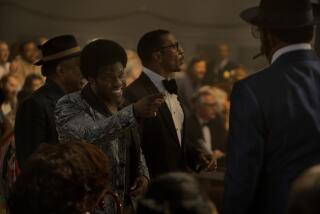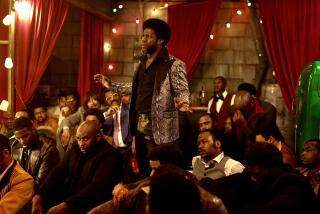William Witney, 86; B-Movie Action Director
William Witney, the Republic Pictures action director who made the studio’s greatest cliffhanger serials during its B-movie heyday in the 1930s and ‘40s and introduced the now-standard practice of choreographing fight scenes, died Sunday in a nursing home in Jackson, Calif. He was 86.
Witney, who had been in ill health since suffering a stroke in 1995, died of complications from that stroke and several subsequent ones.
A specialist in outdoor action and stunt direction, Witney directed or co-directed 23 of Republic’s best-known serials between 1937 and 1946, including “The Lone Ranger,” “Spy Smasher,” “Perils of Nyoka,” “Drums of Fu Manchu,” “Adventures of Captain Marvel,” “Zorro’s Fighting Legion” and “Dick Tracy vs. Crime, Inc.”
Witney also directed 27 Roy Rogers westerns from 1946 to 1951, a period in which he diminished the musical content of the Rogers films in favor of more serious story lines.
“Everybody considers Bill Witney the greatest action director in B movies,” said Boyd Magers, editor and publisher of Western Clippings magazine.
“He just knew how to put things together for the screen--the fights, the wagon wrecks, the falls off the cliffs, whatever; they were just expertly done,” Magers said.
Witney’s Republic serials served as the inspiration for Steven Spielberg’s “Indiana Jones” movies. And director Quentin Tarantino, a Witney fan, has praised his rough and believable action scenes and visual style in films such as “The Golden Stallion” with Rogers and “Stranger at My Door,” a western starring Macdonald Carey.
“I’ve found directors of some of these movies who I’m really into, but William Witney is ahead of them all, the one whose movies I can show to anyone and they are just blown away,” Tarantino told the New York Times in 2000.
In an era dominated by John Ford, Howard Hawks and other legendary directors of “A” pictures, Witney was not publicly heralded during his prime.
“The people in the industry knew what he was doing, but being at Republic, you didn’t get the notoriety directors got at the major studios,” Magers said.
Born in Lawton, Okla., in 1915, he moved with his family to California when he was an infant. After graduating from Coronado High School, he enrolled in a small school in San Diego to help him cram for his entrance exams for the U.S. Naval Academy in Annapolis, where he had an appointment for 1934.
But after a 1933 trip to Hollywood to visit his sister, he never made it to Annapolis.
Witney’s brother-in-law was a serial director for Mascot Pictures, a Poverty Row production studio that specialized in cliffhanger serials. Witney became an office boy at the studio.
After Mascot merged into the newly formed Republic Pictures two years later, he was promoted to script clerk and then to film editor.
In 1937, while Witney was working on the Utah location of the “The Painted Stallion,” the serial’s director was removed and Witney was asked to take over the project. He was 21.
Witney’s most frequent co-director on the serials was John English, who preferred directing the interior dialogue scenes and having Witney handle the action scenes.
“John was a boudoir man,” Witney recalled years later. “I’m an outdoor man and a good horseman. So even though I could do good boudoir stuff, when we worked together, I mostly shot the action and outdoor scenes.”
Witney also worked frequently with legendary stuntman Yakima Canutt, best known for a stunt in Ford’s “Stagecoach,” in which he plays an Indian who leaps from a running horse to the lead horse of the coach team, is then shot and dragged beneath the racing coach.
The legendary stunt was nothing new to Witney.
“We did that in serials 10 times with Yak,” Witney said. “It was Yak who brought the idea to Ford....”
Witney learned to choreograph screen fights after watching choreographer-turned-director Busby Berkeley rehearse a dance number at Warner Bros.
As related in his 1996 memoir, “In a Door, Into a Fight, Out a Door, Into a Chase,” Witney said he was never satisfied with the way movie fights were shot.
In those days, the stuntmen more or less had a free-for-all as they mixed it up in front of the camera.
“The fights always seemed to be OK for the first punch,” Witney wrote. “Then the stuntmen were always out of place for the next punch. By the time three or four minutes had passed, the stuntmen were out of breath, scattered all over the set and seemed to be staggering around waiting for someone to hit them.”
Then Witny watched Berkeley at work filming a sequence with 40 dancers.
“He was lining up all the girls for just one little movement,” Witney recalled in an interview. “He got it perfect. Then he sent them back to rehearse another little movement, shot it, and then maybe a few close-ups later to put in between those shots.”
Borrowing Berkeley’s method, Witney began filming fight sequences by breaking them into shorter segments, changing camera angles and including close-ups for greater audience impact.
Stuntmen today continue the tradition begun by Witney, but now they are under the direction of stunt coordinators.
“Doing the choreography ahead of time actually speeded up and got much better-looking fights and were better for editing,” said Loren Janes, a veteran stunt coordinator who has worked with Witney.
“Bill was a fabulous director with a great sense of action and what it takes to do it,” Janes said. “He had close contact directly with the stuntmen and got a lot of ideas from them. He just had a natural sense of action and where to put the camera, and he understood the physical aspects and the danger, and knew what was possible and wasn’t.”
After serving in a Marine combat photography unit in World War II, Witney returned to Republic, where he directed his last serial, “The Crimson Ghost,” in 1946, and took over directing 27 Roy Rogers westerns.
“He changed the whole complexion of Roy’s pictures,” Magers said. “Roy’s pictures had been very musical, ‘Oklahoma’-oriented and had gotten away from the action content, and when Bill came along in the late ‘40s to direct Roy’s pictures, he really put a life back in them and just rejuvenated Roy and gave him a whole new life on the screen.”
In the ‘50s, Witney directed nine westerns with singing cowboy Rex Allen and dozens of episodes of Republic’s television series such as “Stories of the Century” and “Frontier Doctor,” starring Allen.
After Republic ceased production in 1956, Witney moved to American International Pictures, where he directed “The Bonnie Parker Story” starring Dorothy Provine in 1958; and “Paratroop Command,” a realistic World War II adventure.
Also Worked in Television
He also worked steadily in television, his credits including “Sky King,” “Zorro,” “Bonanza,” “Tales of Wells Fargo,” “Laramie,” “The Virginian,” “The Wild Wild West” and “The High Chaparral.”
Witney’s first wife, Maxine Doyle Witney, died in 1973 after 35 years of marriage. Remarried in 1977, Witney and his wife, Beverly, moved to the northern California town of Pioneer.
He is survived by his wife; a son, John of Truckee, Calif.; and a stepson, Larry Trouba of San Diego.
Memorial services are pending.


